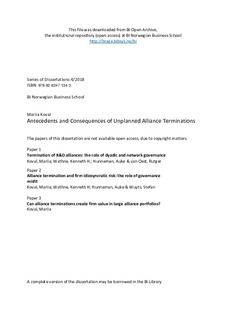Antecedents and Consequences of Unplanned Alliance Terminations
Doctoral thesis
Permanent lenke
http://hdl.handle.net/11250/2497367Utgivelsesdato
2018Metadata
Vis full innførselSamlinger
Sammendrag
Despite their evident advantages, more than 50 percent of strategic alliances terminate prematurely. Still, little is known about causes of alliance terminations and even less is known about subsequent performance consequences for partnering firms. The dissertation seeks to answer the following questions: why do strategic alliances terminate prematurely and how do alliance terminations affect firm performance. The first paper investigates the antecedents of unplanned alliance terminations. The context of the study is R&D alliances. Specifically, the paper examines how governance of R&D alliances tend to reduce the risk of knowledge appropriation present in such alliances, and, consequently, the hazard of an alliance termination. The results show that dyadic and network governance structures play a complementary role in decreasing the hazard of an unplanned alliance termination. The second paper focuses on the consequences of an unplanned alliance termination for firm idiosyncratic risk. The paper examines whether the way in which an alliance is organized can provide insights into the effects of an unplanned alliance termination on firm idiosyncratic risk. The findings show that termination of the misgoverned alliance decreases firm idiosyncratic risk. Importantly, this effect is contingent on how long the alliance has lasted. The third paper studies the consequences of an unplanned alliance termination for firm value. Specifically, the paper examines the link between an announcement of an unplanned alliance termination and a firm’s abnormal stock returns. The results show that an announcement of an unplanned alliance termination increases a firm’s abnormal returns when a firm has a larger alliance portfolio. This effect is moderated by the amount of a firm’s alternative resources (own or acquired), general partnering experience and experience with the same partner (i.e., partner-specific experience). The findings from the dissertation serve to enhance managers’ understanding of the antecedents and consequences of unplanned alliance terminations.
